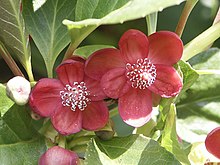Schisandra
| Schisandra | |
|---|---|

| |
| Schisandra sinensis | |
| Scientific classification | |
| Kingdom: | |
| (unranked): | |
| Order: | |
| Family: | |
| Genus: | Schisandra |
| Species | |
Schisandra (Magnolia Vine) is a genus of twining shrub that generally climb on other vegetation. Some early publications misspell the name as "Schizandra," but "Schisandra" is correct. Various authors have included the plants in the Illiciaceae [2][3][4]
Some species are commonly grown in gardens as ornamentals. It is a hardy deciduous climber which thrives in almost any kind of soil; its preferred position is on a sheltered, shady wall. It may be propagated by cutting off half-matured shoots in August.
The genus has 25 accepted species, most of the native to eastern Asia. Species include: S. chinensis, S. glaucescens, S. glabra, S. rubriflora and S. rubrifolia.
Description

Schisandra is native to East Asia, and its dried fruit is sometimes used medicinally. The berries of S. chinensis are given the name wu wei zi in Chinese (五味子; pinyin: wǔ wèi zi), which translates as "five flavor fruit" because they possess all five basic flavors in Chinese herbal medicine: salty, sweet, sour, pungent (spicy), and bitter. In traditional Chinese medicine it is used as a remedy for many ailments: to resist infections, increase skin health, and combat insomnia, coughing, and thirst[citation needed].
Species
Over 19 species of the genus are said to be used in Chinese medicine, mostly as sedatives and tonic agents.
Chemistry
The extract of S. rubriflora, a native of the Yunnan province, was found to contain complex and highly oxygenated nortriterpenoids called rubriflorins A-C.[5]
See also
References
- ^ Michaux, André. 1803. Flora Boreali-Americana 2: 218–219, pl. 47.
- ^ Hutchinson, J. 1973. The Families of Flowering Plants, ed. 3. Oxford. Pp. 161-162. Smith, A. C. 1947. The families Illiciaceae and Schisandraceae. Sargentia 7: 1-224.
- ^ Flora of North America vol 3
- ^ Flora of China v 7 p 41
- ^ Xiao, W.-L. et al.. J. Nat. Prod. 2007, Web release : May 10th.
External links
- Panossian A., Wikman G. Pharmacology of Schisandra chinensis Bail.: An overview of Russian research and uses in medicine . Journal of Ethnopharmacology. Vol 118/2 pp 183-212. doi:10.1016/j.jep.2008.04.020
- Schisandraceae [sensu stricto] in the Flora of North America
